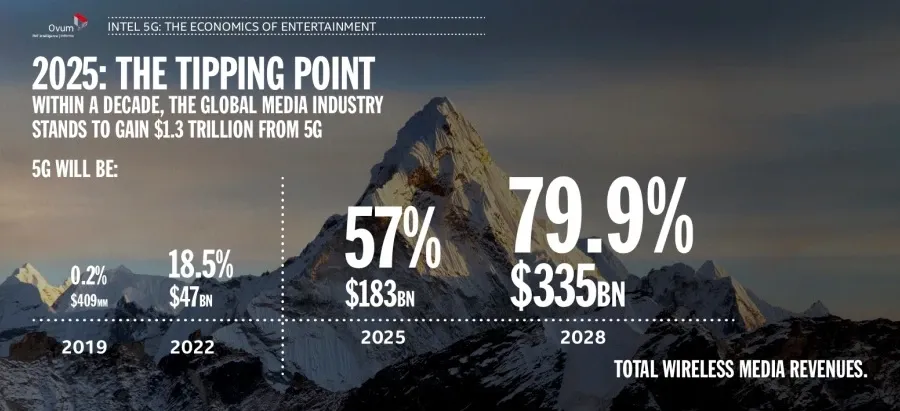According to “5G Economics of Entertainment Report“, commissioned by Intel and conducted by Ovum, over the next decade (2019-2028) media and entertainment companies will be competing to win a share of a near $3 trillion cumulative wireless revenue opportunity. Experiences enabled by 5G networks will account for nearly half of this revenue opportunity (close to $1.3 trillion).
“5G will inevitably shake up the media and entertainment landscape. It will be a major competitive asset if companies adapt. If not, they risk failure or even extinction. This wave of 5G transformation will not be the purview of any singular industry, and now is certainly the time for all business decision-makers to ask: Is your business 5G-ready?“ said Jonathan Wood, general manager of Business Development & Partnerships, 5G Next Generation and Standards at Intel.
The report says that as early as 2025, 57 percent of global wireless media revenues will be generated by using the super-high-bandwidth capabilities of 5G networks and the devices that run on 5G. The low latency of these networks means that no video will stall or stop - livestreaming and large downloads will happen in the blink of an eye.
The “5G Economics of Entertainment Report“ forecasts that 5G will accelerate content consumption, including mobile media, mobile advertising, home broadband and TV, and improve experiences across a broad range of new immersive and interactive technologies, unleashing the full potential of augmented reality (AR), virtual reality (VR) and new media. The average monthly traffic per 5G subscriber will grow from 11.7GB in 2019 to 84.4GB per month in 2028, at which point video will account for 90 percent of all 5G traffic.
Evolved 3G and 4G networks would offer a degraded experience because the capacity will be insufficient to handle the increased video viewing time, content evolution to higher resolutions, more embedded media and immersive experiences. Forecast to provide $140 billion in cumulative revenues (2021-2028), expanded AR and VR experiences may also enable a whole new channel for content producers to reach consumers.
Immersive and new media applications, applications and capabilities that are currently nonexistent, will reach unprecedented scale by 2028, forecast to generate more than $67 billion annually or the value of the entire current global mobile media market (video, music and games) in 2017.
Beyond media and entertainment, all industries are having to adapt to disruptive changes in the business environment, consumers’ habits and public expectations. Businesses are trying to imagine how 5G will transform and disrupt their industry, society and even global competitiveness, as well as beginning to formulate their strategy to embrace the capabilities of 5G. Without the promise of what 5G can provide, growth in many industries may remain stagnant or even decline.





















